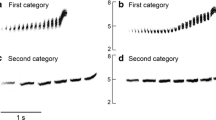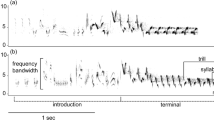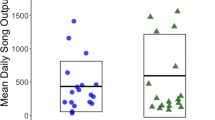Abstract
The fee-bee song of male black-capped chickadees (Poecile atricapillus) is considered a single-type song that singers transpose up and down a continuous frequency range. While the ability to shift song pitch in this species provides a mechanism for song matching as an aversive signal in male-male territorial song contests, the functional significance of this behaviour during the “solo” performances of males during the dawn chorus is unclear. We analysed the dawn chorus songs and singing behaviour of males whose winter-flock dominance status we determined. We used correlation analysis to show that pitch shifts were accompanied by changes to other fine structural characteristics in song, including temporal and relative amplitude parameters. We also found that songs of socially dominant males and songs of their most subordinate flockmates could be distinguished using these methods by the way they performed a between-note frequency measure accompanying pitch shifts. That is, a ratio measure of the internote frequency interval remained constant for songs of high-ranking birds despite changes in absolute pitch, while low-ranking males sang a smaller ratio as they shifted to higher absolute pitches. These findings identify previously unrecognised variation in the songs of black-capped chickadees. More importantly, they indicate a mechanism by which pitch shifting during the dawn chorus of black-capped chickadees could provide a reliable indicator of relative male quality.



Similar content being viewed by others
References
Adams DC, Anthony CD (1996) Using randomization techniques to analyse behavioural data. Anim Behav 51:733–738
Christie PJ, Mennill DJ, Ratcliffe LM (2003) Black-capped chickadee song is individually distinctive over long broadcast distances. Behaviour (in press)
Desrochers A (1990) Sex determination of black-capped chickadees with a discriminant analysis. J Field Ornith 61:79–84
Ficken MS, Weise CM, Popp JW (1990) Dominance rank and resource access in winter flocks of black-capped chickadees. Wilson Bull 102:623–633
Forstmeier W, Kempenaers B, Meyer A, Leisler B (2002) A novel song parameter correlates with extra-pair paternity and reflects male longevity. Proc R Soc Lond B 269:1479–1485
Fotheringham JR, Ratcliffe L (1995) Song degradation and estimation of acoustic distance in black-capped chickadees (Parus atricapillus). Can J Zool 73:858–868
Hailman, JP (1989) The organization of major vocalizations in the Paridae. Wilson Bull 101:305–343
Hasselquist D, Bensch S, von Schantz T (1996) Correlation between male song repertoire, extra-pair paternity and offspring survival in the great reed warbler. Nature 381:229–232
Hill BG, Lein MR (1987) Function of frequency-shifted song of black-capped chickadees. Condor 89:914–915
Horn AG, Falls JB (1996) Categorization and the design of signals: the case for song repertoires. In: Kroodsma DE, Miller EH (eds) Ecology and evolution of acoustic communication in birds. Cornell University Press, Ithaca, N.Y., pp 121–135
Horn AG, Leonard ML, Ratcliffe L, Shackleton SA, Weisman RG (1992) Frequency variation in songs of black-capped chickadees (Parus atricapillus). Auk 109:847–852
Hulse SH, Cynx J (1985) Relative pitch perception is constrained by absolute pitch in songbirds (Mimus, Molothrus, and Sturnus). J Comp Psych 99:176–196
Hulse SH, Takeuchi AH, Braaten RF (1992) Perceptual invariances in the comparative psychology of music. Music Perception 10:151–184
Hurly TA, Ratcliffe L, Weisman R (1990) Relative pitch recognition in white-throated sparrows, Zonotrichia albicollis. Anim Behav 44:149–156
Hurly TA, Weary D, Ratcliffe L, Weisman R (1992) White-throated sparrows, Zonotrichia albicollis, can perceive pitch change in conspecific song by using frequency ratio independent of the frequency difference. J Comp Psych 106:388–391
Kroodsma DE, Byers BE, Halkin SL, Hill C, Minis D, Bolsinger JR, Dawson J, Donelan E, Farrington J, Gill FB, Houlihan P, Innes D, Keller G, Macaulay L, Marantz CA, Ortiz J, Stoddard PK, Wilda K (1999) Geographic variation in black-capped chickadee songs and singing behavior. Auk 116:387–402
Lambrechts MM (1996) Organization of birdsong and constraints on performance. In: Kroodsma DE, Miller EH (eds) Ecology and evolution of acoustic communication in birds. Cornell University Press, Ithaca, N.Y., pp 305–320
Manly BJF (1997) Randomization, bootstrap and Monte Carlo methods in biology. Chapman and Hall, London
Meigs JB, Smith DC, Van Buskirk J (1983) Age determination of Black-capped Chickadees. J Field Ornith 54:283–286
Mennill DJ, Ratcliffe LM (2004) Overlapping and matching in the song contests of black-capped chickadees. Anim Behav (in press)
Mennill DJ, Ratcliffe LM, Boag PT (2002) Female eavesdropping on male song contests in songbirds. Science 296:873
Morton ES, Young K (1986) A previously undescribed method of song matching in a species with a single song “type,” the Kentucky warbler (Oporornis formosus). Ethology 73:343–352
Naguib M, Mundry R, Hultsch H, Todt D (2002) Responses to playback of whistle songs and normal songs in male nightingales: effects of song category, whistle pitch, and distance. Behav Ecol Sociobiol 52:216–223
Otter K, Ratcliffe L (1993) Changes in singing behaviour of male black-capped chickadees (Parus atricapillus) following mate removal. Behav Ecol Sociobiol 33:409–414
Otter K, Ratcliffe L (1996) Female initiated divorce in a monogamous songbird: abandoning mates for males of higher quality. Proc R Soc Lond B 263:351–354
Otter K, Ratcliffe L, Boag PT (1994) Extra-pair paternity in the black-capped chickadee. Condor 96:218–222
Otter K, Chruszcz B, Ratcliffe L (1997) Honest advertisement and song output during the dawn chorus of black-capped chickadees. Behav Ecol 8:167–173
Otter K, Ratcliffe L, Michaud D, Boag PT (1998) Do female black-capped chickadees prefer high-ranking males as extra-pair partners? Behav Ecol Sociobiol 43:25–36
Otter K, Ratcliffe L, Njegovan M, Fotheringham J (2002) Importance of frequency and temporal song matching in black-capped chickadees: evidence from interactive playback. Ethology 108:181–191
Podos J (1996) Motor constraints on vocal development in a songbird. Anim Behav 51:1061–1070
Podos J (2001) Correlated evolution of morphology and vocal signal structure in Darwin’s finches. Nature 409:185–188
Ratcliffe LM, Otter K (1996) Sex differences in song recognition. In: Kroodsma DE, Miller EH (eds) Ecology and evolution of acoustic communication in birds. Cornell University Press, Ithaca, N.Y., pp 339–355
Ratcliffe L, Weisman R (1992) Pitch processing strategies in birds: a comparison of laboratory and field studies. In: McGregor PK (ed) Playback and studies of animal communication. Plenum, New York, pp 211–223
Ryan MJ, Brenowitz EA (1985) The role of body size, phylogeny, and ambient noise in the evolution of bird song. Am Nat 126:87–100
Ryan MJ, Rand AS (1993) Species recognition and sexual selection as a unitary problem in animal communication. Evolution 47:647–657
Shackleton SA, Ratcliffe L (1993) Development of song in hand-reared black-capped chickadees. Wilson Bull 105:637–644
Shackleton SA, Ratcliffe L (1994) Matched counter-singing signals escalation of aggression in black-capped chickadees (Parus atricapillus). Ethology 97:310–316
Shackleton SA, Ratcliffe L, Horn AG, Naugler CT (1991) Song repertoires of Harris’ Sparrows (Zonotrichia querula). Can J Zool 69:1867–1874
Shackleton SA, Ratcliffe L, Weary DM (1992) Relative frequency parameters and song recognition in black-capped chickadees. Condor 94:782–785
Smith SM (1988) Extra-pair copulations in Black-capped Chickadees: the role of the female. Behaviour 107:15–23
Smith SM (1991) The black-capped chickadee: behavioural ecology and natural history. Cornell University Press, Ithaca, N.Y.
Staicer CA, Spector DA, Horn AG (1996) The dawn chorus and other diel patterns in acoustic signaling. In: Kroodsma DE, Miller EH (eds) Ecology and evolution of acoustic communication in birds. Cornell University Press, Ithaca, N.Y., pp 426–453
Suthers RA, Goller F (1997) Motor correlates of vocal diversity in songbirds. In: Nolan V Jr, Ketterson ED, Thompson CF (eds) Current ornithology, vol 14. Plenum, New York, pp 235–287
Suthers RA, Goller F, Pytte C (1999) The neuromuscular control of birdsong. Philos Trans R Soc Lond B 354:927–939
Vallet E, Beme I, Kreutzer M (1998) Two-note syllables in canary songs elicit high levels of sexual display. Anim Behav 55:291–297
Weary DM, Weisman RG, Lemon RE, Chin T, Mongrain J (1991) Use of relative frequency of notes by veeries in song recognition and production. Auk 108:977–981
Weisman R, Ratcliffe L (1989) Absolute and relative pitch processing in black-capped chickadees (Parus atricapillus). Anim Behav 38:685–692
Weisman R, Ratcliffe L, Johnsrude I, Hurly TA (1990) Absolute and relative pitch production in the song of the black-capped chickadee. Condor 92:118–124
Acknowledgements
We gratefully acknowledge the efforts of all the individuals who helped in collecting our recordings and in song analysis: Dev Aiama, Ryan DeBruyn, Amy MacDougall, Bridget Meigs and Nicole Vreeswyck Wilson. We also thank the management and staff of the Queen’s University Biological Station for their support and John Toohey as well as the Curtis, Lundell, Warren, Weatherhead-Metz and Zink families for access to adjacent properties. This research was supported by American Ornithologists’ Union research awards to P.J.C and D.J.M., Animal Behavior Society research awards to P.J.C and D.J.M., an E.A. Bergstrom Memorial Research Award to D.J.M., a Society of Canadian Ornithologists’ Baillie Award to D.J.M., Natural Sciences and Engineering Research Council of Canada (NSERC) postgraduate scholarships to D.J.M. and an NSERC research grant to L.M.R.
Author information
Authors and Affiliations
Corresponding author
Additional information
Communicated by I. Hartley
Rights and permissions
About this article
Cite this article
Christie, P.J., Mennill, D.J. & Ratcliffe, L.M. Pitch shifts and song structure indicate male quality in the dawn chorus of black-capped chickadees. Behav Ecol Sociobiol 55, 341–348 (2004). https://doi.org/10.1007/s00265-003-0711-3
Received:
Revised:
Accepted:
Published:
Issue Date:
DOI: https://doi.org/10.1007/s00265-003-0711-3




